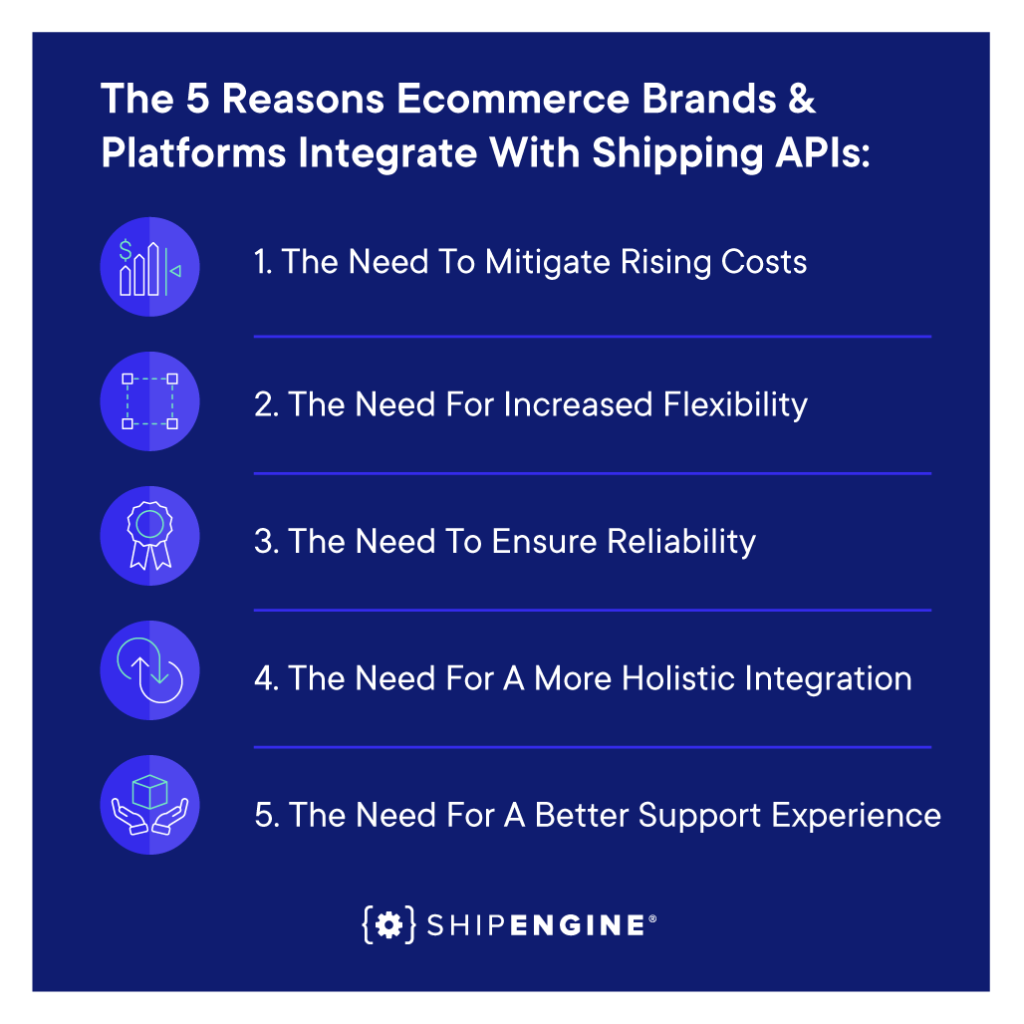
Are you currently using an API for your shipping and logistics workflow?
If not, researching available options can save you and your development team a lot of time and energy, allowing you to focus on other things that will move your business forward: product improvement, research and development, customer acquisition, etc.
Your developers no doubt love building things from scratch, but there are pieces of code that require hours of maintenance even after they are written. That maintenance eats into the sacred time spent building your amazing products and improving your existing workflows.
If you do use a shipping and logistics API provider, are you happy with its performance?
If the answer is “no,” it’s time to prepare for a switch in APIs. As a fast-growing brand or platform, the right API can help you scale your business. Integrating a shipping API into your supply chain unlocks a series of benefits that can accelerate growth. The right shipping API for your company is the one that helps you:
- Reduce costs: Shipping APIs eliminate time spent on carrier integration maintenance and reduce unnecessary returns through global address validation.
- Improve customer service: Shipping APIs make it easier to find and share shipping-related information — like tracking numbers, for example.
- Increase efficiency: Shorten the amount of time it takes to print labels and complete other shipping-related tasks.
If you aren’t getting these benefits from your provider, it’s time to find a different API and associated workflows that empower your business to grow — and that scale with you no matter how big your company gets.
What to Look for in a Shipping API
The search for a shipping API requires in-depth research so that you can ultimately choose the best product for your business. Thankfully, certain needs are universal for potential shipping API users. As you look for the right API partner, look for the product that helps you directly address these 5 needs.
1. The Need to Mitigate Rising Costs
The pandemic created an ecommerce boom that experts expect to continue growing over time. But the cost of implementing shipping and logistics services within your current technology stack may be rising, too, due to vendor costs or to homegrown development and maintenance expenses. The right shipping API helps you mitigate the rising cost of keeping up with the fast-paced changes that carriers are making.
2. The Need for Increased Flexibility
Your business deserves better-than-adequate technologies that deliver the flexibility needed to customize workflows and scale as you grow. As the demand for your products increases, you will need to quickly pivot to seize new opportunities — and you’ll need your development team to be able to pivot with you. Worrying about your tech stack’s inability to adapt or improve should not be on your dev team’s backlog — you should be able to depend on your APIs to grow and adapt along with you and your other services.
3. The Need to Ensure Reliability
99.99% uptime matters. Full stop. Your needs (and the needs of your merchants) are more complex in a post-COVID-19 world, and customer expectations are higher than ever after the pandemic. What do these new expectations include? Customers now expect to:
- Be able to identify and select an appropriate delivery option
- Know when their orders will arrive
- Count on their orders arriving quickly
Your business is competing with the likes of Amazon and Walmart. You will need to create a fast, reliable, Amazon-like fulfillment experience in order to meet customer expectations and win market share. You cannot create an industry-leading experience without a highly performant tech stack. Which is why you can’t settle for anything less than 99.99% on this point.
4. The Need for a More Holistic Integration
Your development and customer success teams likely gather to share feedback with each other on a regular basis. When they do, they likely talk about how to provide the best end-to-end customer experience. According to LaserShip, 84% of customers will not give a company repeat business after a single bad shipping experience. Using APIs that can be “plugged in” to fill specific needs and services in your workflows is paramount to success. Also, ensure that your APIs offer both a breadth and depth of carrier integrations so that you can always choose services that deliver the best customer experience possible.
5. The Need for a Better Support Experience
Finally, your API provider should offer responsive support through multiple channels — especially via chat, which is perfect for quick questions. Chat eliminates the need to schedule online calls or meetings, and it allows developers to get the information they need in real-time. Chat support (when provided effectively) allows developers to quickly get back to the critical work of enhancing a product or service.
Before choosing an API, also ask about support during the integration process. Implementation specialists and solution architects can be immensely helpful during the integration process, allowing your team to move faster and begin realizing value from a shipping API more quickly than without integration support.

We Can Help You Solve Shipping
At ShipEngine, we’ve designed and built our shipping APIs and related services to directly address the 5 needs outlined above. If you’re searching for a shipping API provider, or if you’re thinking of switching API providers, we can answer your questions and provide expert guidance.
Contact us to learn more about how we can help you solve shipping.


Leave a Reply